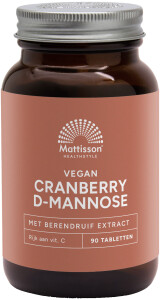The best supplements for kidney function

- Formula for the liver and the kidneys
- Contains berberine, milk thistle, burdock root and chicory

- 350 mg nettle leaf per capsule
- Plus 75 mg of camu camu per capsule

- Formula for bladder, kidneys and urinary tract
- Contains cranberry, D-mannose, bearberry and vitamin C

- Herbal complex for the urinary tract and fluid balance
- Contains 5 herbs: parsley, horsetail, juniper, bearberry and goldenrod
Buy the best supplements for the kidneys here. Or read more below.

The kidneys are the foundation of our urinary system. The kidneys are located at the back of the abdominal cavity, on either side of the spine. They are fist-sized bean-shaped organs. The kidneys are very hardworking organs with a variety of functions. One of the best known is removing waste products from the blood.
It usually takes a long time before symptoms of the kidneys are noticed. This is because the symptoms are quite common so these complaints are not discovered until a lot of damage has already occurred.
The functions of the kidneys are very hard and varied.
Functions of the kidneys
- Filtering and excreting wastes from the blood through the urinary tract
- Regulation of fluid and electrolyte balance
- Detoxification of drugs and other toxic substances
- Role in the formation of glucose (gluconeogenesis) to maintain blood sugar levels throughout the night
- Maintain acid-base balance
- Recovery of nutrients in short supply
- Activation of hormones such as calcitriol (vitamin D)
- Activation of various hormones
Performance of the kidneys
The functioning of the kidneys is enormously complex, which is not surprising given the many functions they have. The kidneys contribute to the homeostasis of blood and tissue fluids. The following mechanisms play an important role in filtering the blood and producing urine: ultrafiltration, reabsorption and excretion.
The blood flows through branches of the aorta to the renal artery and then into the kidneys. Each kidney contains about one million nephrons consisting of tiny porous tangle of blood vessels (a kind of sieve corpuscles) where the blood is filtered. That is, water containing dissolved substances is squeezed through the sieve corpuscles, this is called preurine. Large molecules such as red blood cells and proteins remain in the blood.
The nephrons produce as much as between 140 and 180 liters of preurine also called ultrafiltrate daily. Most of it, including useful nutrients such as glucose and amino acids, is reabsorbed. We call this resorption.
Finally, 1.5 to 2 liters of urine remains, which is collected in the renal pelvis and leaves the body through ureters and the bladder. Urine contains the waste products of our metabolism and may contain a minimal amount of protein.
When urine contains too much protein, something is wrong with the nephron's finest filter, the podocyte layer. Its job is to prevent large molecules such as proteins from being filtered out of the blood and into the urine.
The construction of the kidneys
The nephrons
As mentioned, the kidneys are made up of nephrons. A nephron is a functional filter unit. There are more than 1 million nephrons in each kidney, which are engaged in blood purification and contribute to urine production. A nephron consists of a network of blood vessels (glomeruli) surrounded by Bowman's capsule (these together form Malpighi's corpuscle or kidney corpuscle) and a renal canal. Under pressure, filtration of blood takes place in the kidney corpuscle. After which the preurine flows through the renal tubule into the renal pelvis.
The renal tubule (tubulus) consists of 4 parts
The proximal tubule, the loop of Henle, the distal tubule and the collecting duct. In these parts the resorption of water, glucose and amino acids from preurine takes place, each with its own function in this process. Thus, the loop of Henle consists of a descending part and an ascending part. In the descending part the exchange of water from preurine takes place and in the ascending part dissolved substances such as salts and minerals are passed through.
Production of hormones
Kidneys are also involved in the production of the hormones renin and erythropoietin. Renin is part of the RAAS system (renin-angiotensin-aldosterone system). In particular, this system regulates blood pressure. It also regulates water-mineral balance.
Erythropoietin (EPO) stimulates the production of red blood cells in the bone marrow. EPO was in the news negatively for some time because athletes increased their endurance by administering this hormone as a form of doping.
Antidiuretic hormone (ADH)
The resorption of potassium, sodium and water is largely regulated by aldosterone produced in the adrenal gland (via the RAAS system). In addition, reabsorption is also regulated by antidiuretic hormone (ADH) also called vasopressin.
ADH is produced by the hypothalamus in response to dehydration. ADH causes the kidneys to excrete less water so that blood pressure rises.
Vitamin D
Calciferol refers to both Vitamin D3 and D2. Calciferol is produced by the skin under the influence of the sun and it is also available in supplement form. However, this form of vitamin D is not yet biologically active.
Calciferol is transported to the liver where it is converted into 25-OH vitamin D (25-hydroxyvitamin D). This goes on transport toward the kidneys. Where it is then converted to calcitriol (1 alpha25-dihydroxyvitamin) in the mitochondria of the kidneys. This is the active form of Vitamin D that is essential for calcium absorption and maintaining healthy bones.
Written by: Liesbeth Thoen
Reviewed and edited by: Marcella van der Wel
Updated: June 13, 2023
